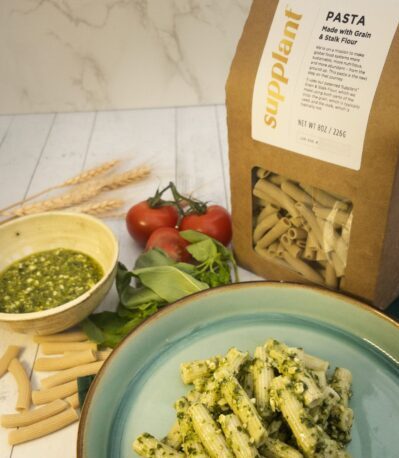[Disclosure: AFN’s parent company, AgFunder, is an investor in The Supplant Company. Scroll down to watch our video interview with founder and CEO Dr. Tom Simmons on the sidelines of the Future Food Tech conference in San Francisco.]

The Supplant Company, a UK-based startup making low-glycemic sugar replacements from upcycled agricultural side streams, has launched its second product: flour incorporating fibers from wheat stalks, “the forgotten half of the harvest.”
Supplant Grain & Stalk Flour—launching into the foodservice market this week—is a wheat flour blend combining elements from the grain and stalk of the plant. It has six times the fiber and fewer calories than all-purpose flour, but delivers similar functionality in baked goods, pasta, and other products, claims the company.
Founder and CEO Dr. Tom Simmons told AFN: “On a wheat plant, two-thirds of the above-ground biomass is not currently used [for human food]. If you think about the energy and inputs needed to grow it, and the carbon emissions, it doesn’t make sense that we’re wasting the high-fiber, low-calorie part of the crop.”
Ingredients from agricultural side streams
But if companies want flour with more fiber, can’t they just buy whole wheat flour, which features all parts of the grain including the germ, endosperm, and fiber-rich bran?
Yes, said Simmons, but the fibers Supplant is extracting from the stalks are not the same as those in the bran, which can deliver unwanted sensory characteristics in some products.
Using Supplant Grain & Stalk Flour, formulators can include more fiber without tradeoffs in appearance or functionality, claimed Simmons, a Cambridge University academic who realized his post-doctoral research on plant science could have exciting real-world applications.
“We’re using an enzymatic process to release fibers from the biomass without extensively breaking them down, which is what we do for our ‘sugars from fiber‘ product. They need to stay as longer chain polymers if you want them to behave like starch rather than sugar.”
Potential customers are attracted by the flour’s nutritional, sustainability and food security credentials, he said, with some focused on boosting fiber or reducing calories and others interested in promoting upcycled ingredients.
Sugars from fiber
Simmons spoke to AFN at the Future Food Tech conference in San Francisco earlier this month about the company’s flagship product, sugars from fiber: a low-glycemic blend of sugars extracted from upcycled feedstocks that performs like table sugar but is metabolized more like fiber.
From allulose to erythritol, food manufacturers have several alternatives to table sugar to choose from, said Simmons.
But existing options are often expensive, hard to scale, or lack all of the properties formulators know and love about sucrose (browning, caramelization, etc), said Simmons, who has filed a suite of patents around technology that uses enzymes to break down polysaccharides (long chains of sugars) in fibrous plant materials into oligosaccharides and sugars, which are then combined to create ‘sugars from fiber.’
“We can use wheat straw, corn cobs, corn starks, oat hulls… we take them grind them up, and we digest the fibers with enzymes. The enzymes break the long chains of sugar in the fiber to smaller chains of sugars, which behave more like cane sugar, but because they’re still derived from the fiber, they are low calorie, low glycemic, and prebiotic.” Dr. Tom Simmons
Performs like sugar, metabolized like fiber?
Supplant sugars from fiber performs just like sucrose in food applications from cakes to chocolate and can be used to replace some or all of the sugar in a given application, depending on the sweetness level you’re looking for, said Simmons, who has raised $28 million to date from investors including Coatue, EQT, Felicis, Khosla Ventures, Manta Ray, and AgFunder.
For nutrition labeling purposes, it has 1.8 calories per gram (vs 4 calories per gram for table sugar), and is classified as a sugar and a fiber, with the fiber portion of the mix conforming to the FDA’s new definition of dietary fiber.
“It’s metabolized like fiber, and it reaches the large intestine where some of it passes through you and some is metabolized by gut bacteria, so that’s a prebiotic effect,” added Simmons, who is initially focusing on the US market, where the company has already put together GRAS determinations for its products.
10 grams of Supplant Sugars from fiber contains 18 calories (vs 40 for regular table sugar), 10 grams carbs, 1.5 grams of fiber, and 4.5 grams of sugar for nutrition labeling purposes, claims the company.





